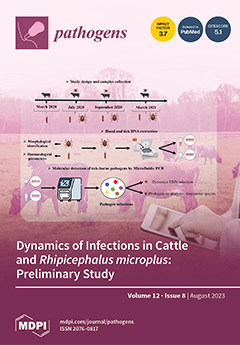Whole-genome sequencing (WGS) was used for the genomic characterization of one hundred and ten strains of
Listeria innocua (
L. innocua) isolated from twenty-three cattle farms, eight beef abattoirs, and forty-eight retail outlets in Gauteng province, South Africa. In silico multilocus sequence
[...] Read more.
Whole-genome sequencing (WGS) was used for the genomic characterization of one hundred and ten strains of
Listeria innocua (
L. innocua) isolated from twenty-three cattle farms, eight beef abattoirs, and forty-eight retail outlets in Gauteng province, South Africa. In silico multilocus sequence typing (MLST) was used to identify the isolates’ sequence types (STs). BLAST-based analyses were used to identify antimicrobial and virulence genes. The study also linked the detection of the genes to the origin (industries and types of samples) of the
L. innocua isolates. The study detected 14 STs, 13 resistance genes, and 23 virulence genes. Of the 14 STs detected, ST637 (26.4%), ST448 (20%), 537 (13.6%), and 1085 (12.7%) were predominant, and the frequency varied significantly (
p < 0.05). All 110 isolates of
L. innocua were carriers of one or more antimicrobial resistance genes, with resistance genes
lin (100%),
fosX (100%), and
tet(
M) (30%) being the most frequently detected (
p < 0.05). Of the 23 virulence genes recognized, 13 (
clpC,
clpE,
clpP,
hbp1,
svpA,
hbp2,
iap/cwhA,
lap,
lpeA,
lplA1,
lspA,
oatA,
pdgA, and
prsA2) were found in all 110 isolates of
L. innocua. Overall, diversity and significant differences were detected in the frequencies of STs, resistance, and virulence genes according to the origins (source and sample type) of the
L. innocua isolates. This, being the first genomic characterization of
L. innocua recovered from the three levels/industries (farm, abattoir, and retail) of the beef production system in South Africa, provides data on the organism’s distribution and potential food safety implications.
Full article






